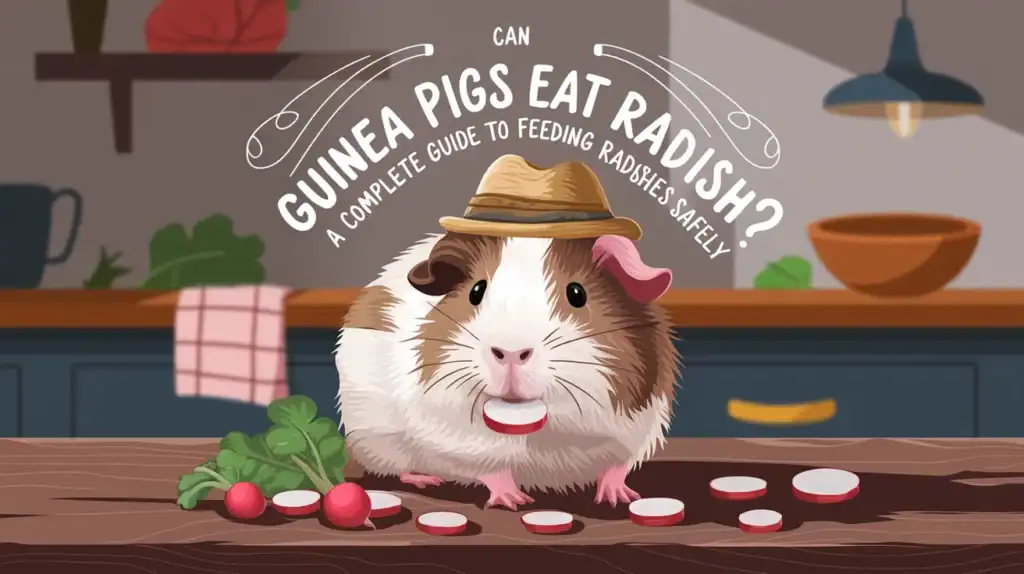Guinea pigs are adorable, social creatures that thrive on a diet rich in fresh vegetables. But not all veggies are created equal when it comes to their health. One question that often pops up is: Can guinea pigs eat radishes? The short answer is yes, but there’s a lot more to it than a simple yes or no. In this comprehensive guide, we’ll dive deep into the nutritional benefits, potential risks, and best practices for feeding radishes to your furry friends.
Can Guinea Pigs Eat Radishes?
Yes, guinea pigs can eat radishes, but only in moderation. Radishes are not toxic to guinea pigs, but they contain certain compounds that can cause digestive issues if overfed. Both the radish root and the radish tops (leaves) are safe for guinea pigs, but they have different nutritional profiles and should be fed accordingly.
Why Moderation is Key
Radishes contain goitrogens, which are substances that can interfere with thyroid function if consumed in large quantities. They also have a moderate amount of calcium, which, while essential, can lead to bladder or kidney stones if fed excessively. Additionally, the natural compounds in radishes can cause bloating or diarrhea if your guinea pig eats too much.
Nutritional Information for Radishes
Understanding the nutritional content of radishes is crucial to determining how they fit into your guinea pig’s diet. Here’s a breakdown of the key nutrients in radishes (per 100g):
| Nutrient | Amount | Importance for Guinea Pigs |
| Calories | 16 kcal | Low-calorie, great for weight management |
| Vitamin C | 14.8 mg | Prevents scurvy, boosts immunity |
| Fiber | 1.6 g | Supports healthy digestion |
| Calcium | 25 mg | Essential for bones but risky in excess |
| Phosphorus | 20 mg | Works with calcium for bone health |
| Sugar | 1.86 g | Low but should be monitored |
| Water Content | 95% | Keeps guinea pigs hydrated |
Key Takeaways from the Table
- Vitamin C: Guinea pigs cannot produce their own Vitamin C, so they rely on dietary sources. Radishes provide a decent amount, but they’re not the best source compared to bell peppers or kale.
- Calcium: While essential, too much calcium can lead to urinary stones, a common issue in guinea pigs.
- Fiber: Supports digestion, which is critical for guinea pigs’ sensitive stomachs.
Benefits of Radishes for Guinea Pigs
Radishes offer several health benefits for guinea pigs when fed in moderation:
Vitamin C Boost
Guinea pigs need 10-30 mg of Vitamin C daily to prevent scurvy, a condition caused by Vitamin C deficiency. Radishes provide a small but valuable amount of this essential nutrient.
Hydration
With a 95% water content, radishes can help keep your guinea pig hydrated, especially during warmer months.
Fiber for Digestion
The 1.6g of fiber in radishes supports a healthy digestive system, preventing issues like constipation.
Variety in Diet
Adding radishes to your guinea pig’s diet can provide variety, making mealtime more enjoyable. However, they should never replace staple veggies like bell peppers or leafy greens.
Risks of Feeding Radishes to Guinea Pigs
While radishes have benefits, they also come with risks:
High Calcium Content
Excess calcium can lead to bladder or kidney stones, a painful and potentially life-threatening condition for guinea pigs.
Goitrogens
Radishes contain compounds called goitrogens, which can interfere with thyroid function if consumed in large amounts.
Digestive Issues
Overfeeding radishes can cause bloating, gas, or diarrhea due to their natural compounds.
Sugar Content
While low, the 1.86g of sugar in radishes should still be monitored to prevent obesity.
How to Safely Feed Radishes to Guinea Pigs
To minimize risks and maximize benefits, follow these guidelines:
Serving Size
- Radish Root: 1-2 thin slices, 1-2 times per week.
- Radish Tops: A small handful, 2-3 times per week.
Preparation Tips
- Wash Thoroughly: Remove any pesticides or dirt.
- Cut into Small Pieces: Prevent choking hazards.
- Introduce Gradually: Start with a tiny amount to see how your guinea pig reacts.
Monitor for Reactions
Watch for signs of digestive discomfort, such as bloating or diarrhea. If any issues arise, stop feeding radishes immediately and consult your vet.
Radish Tops vs. Radish Roots
Both parts of the radish plant are safe for guinea pigs, but they have different nutritional profiles:
Radish Tops (Leaves)
- Lower in Calcium and Sugar: Safer to feed more frequently than the root.
- Rich in Vitamin C and Fiber: Great for overall health.
Radish Roots
- Higher in Calcium and Sugar: Should be fed sparingly.
- Crunchy Texture: Provides enrichment and encourages natural chewing behavior.
Alternatives to Radishes for Guinea Pigs
If you’re looking for safer or more nutrient-dense options, consider these vegetables:
- Bell Peppers: High in Vitamin C, low in calcium.
- Cucumber: Hydrating and low in sugar.
- Zucchini: Easy to digest and low in calories.
- Leafy Greens: Romaine lettuce, cilantro, and parsley are excellent choices.
Conclusion
Radishes can be a healthy addition to your guinea pig’s diet when fed in moderation. They provide essential nutrients like Vitamin C and fiber, but their calcium and goitrogen content means they should never be a staple food. Always prioritize variety and consult your vet if you’re unsure about introducing new foods.
By following the guidelines in this article, you can ensure your guinea pig enjoys radishes safely and healthily. Remember, a balanced diet is key to keeping your furry friend happy and thriving!
Frequently Asked Questions (FAQs)
Can guinea pigs eat radish leaves every day?
No, radish tops should be fed in moderation, 2-3 times per week.
Are radishes better than other vegetables for guinea pigs?
Not necessarily. While they offer some benefits, other veggies like bell peppers are more nutrient-dense and safer for daily feeding.
What happens if my guinea pig eats too much radish?
Overconsumption can lead to digestive issues or calcium-related health problems. Always feed in moderation.

